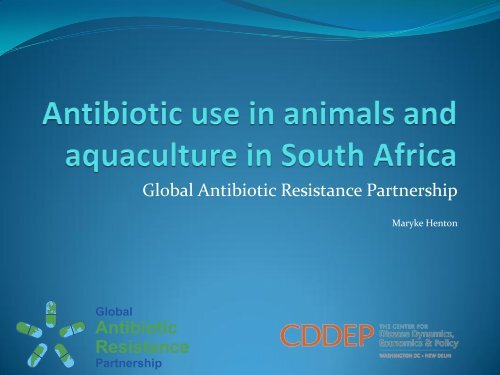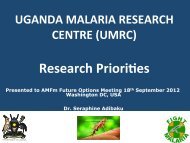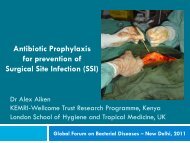Download this tool
Download this tool
Download this tool
Create successful ePaper yourself
Turn your PDF publications into a flip-book with our unique Google optimized e-Paper software.
Global Antibiotic Resistance Partnership<br />
Maryke Henton
Aquaculture<br />
Marine<br />
Abalone farms<br />
Fresh water<br />
Trout<br />
Ornamentals
Bacterial infections of fish and<br />
shellfish<br />
• Fish swim in the equivalent of a bacterial suspension<br />
• They have adequate natural defence mechanisms<br />
against bacterial infections<br />
• They only succumb to bacterial infections when<br />
stressed<br />
• Identification and removal of the stressor is far more<br />
beneficial than antibiotics
Trout showing<br />
haemorrhagic<br />
septicaemia<br />
Aeromonas hydrophila
Administration of antibiotics to fish<br />
and shellfish<br />
• In feed – but sick animals stop feeding<br />
• In water – feasible in fish tanks, but on large farms the<br />
flow rate washes antibiotic away<br />
• Bath – but catching the fish and immersing it in a bath<br />
of diluted antibiotic is stressful<br />
• Valuable specimens may be injected
Marine<br />
• About 8 abalone [Haliotis midae] farms<br />
• West Coast and South Coast up to Hermanus<br />
• Minimal antibiotic use<br />
• Flow rate too rapid for antibiotic administration in<br />
water<br />
• Almost exclusively fed on kelp [Ecklonia maxima]<br />
• Only juveniles fed Abfeed, where it would be possible<br />
to include an antibiotic
Trout Farms<br />
• Trout require cold water<br />
• Only trout farms are in the Lydenberg area and<br />
Drakensberg<br />
• Rapid turnover of fish – ready for market at about 9<br />
months<br />
• Egg laying is seasonal, and eggs have to be imported<br />
during the winter
Trout Farms continued<br />
• Strict quarantine measures for imported trout eggs to<br />
minimize disease transmission<br />
• All the farms are intensive, with high stocking rates<br />
• As there are several trout farms per river, the farmers<br />
tend to co-operate<br />
• Residues should be monitored
Ornamental fish<br />
• Most imported from the Far East<br />
• Fish travel poorly by air, and they arrive stressed and<br />
susceptible to infections<br />
• They carry very resistant bacteria with them as part of<br />
their normal flora<br />
• Virtually no quarantine imposed<br />
• Rapidly sold on via pet shops where they are mixed<br />
with fish already present
Ornamental Fish<br />
• Generally kept in small tanks with recirculating water.<br />
• Koi are kept in large ponds, but water is also<br />
recirculated<br />
• Minimal contamination of the environment by the<br />
resistant bacteria<br />
• Small amounts of antibiotics used to treat ornamental<br />
fish
Antibiotic use in animals<br />
• Use is greatest in intensive farming – pigs and poultry<br />
• Use is greatest in animals slaughtered at a relatively<br />
young age<br />
• Dairy cows – mastitis<br />
• Feed lots to fatten cattle before slaughter
Resistance correlated with disease<br />
• Low levels of resistance in bacteria causing specific<br />
diseases which are not zoonotic<br />
• Low levels of resistance when a disease is rapidly fatal<br />
• High levels of resistance in bacteria causing chronic<br />
diseases<br />
• High levels of resistance in enteric bacteria
Recommendations<br />
• Prudent antimicrobial use<br />
• Biosecurity on farms<br />
• Increased levels of hygiene on farm<br />
• Increased levels of hygiene during food processing<br />
• Encouragement for increased residue detection in<br />
meat, milk and eggs

















